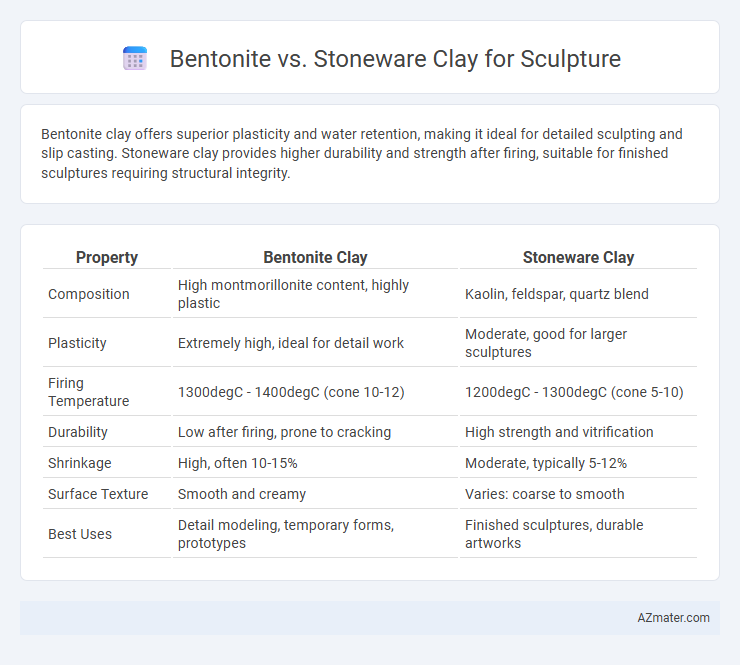Bentonite clay offers superior plasticity and water retention, making it ideal for detailed sculpting and slip casting. Stoneware clay provides higher durability and strength after firing, suitable for finished sculptures requiring structural integrity.
Table of Comparison
| Property | Bentonite Clay | Stoneware Clay |
|---|---|---|
| Composition | High montmorillonite content, highly plastic | Kaolin, feldspar, quartz blend |
| Plasticity | Extremely high, ideal for detail work | Moderate, good for larger sculptures |
| Firing Temperature | 1300degC - 1400degC (cone 10-12) | 1200degC - 1300degC (cone 5-10) |
| Durability | Low after firing, prone to cracking | High strength and vitrification |
| Shrinkage | High, often 10-15% | Moderate, typically 5-12% |
| Surface Texture | Smooth and creamy | Varies: coarse to smooth |
| Best Uses | Detail modeling, temporary forms, prototypes | Finished sculptures, durable artworks |
Overview of Bentonite and Stoneware Clay
Bentonite clay, composed primarily of montmorillonite, is highly plastic and retains moisture well, making it ideal for detailed sculpting and adding strength to clay bodies. Stoneware clay, known for its durability and firing range between 1200degC to 1300degC, is favored for functional ceramics and sculptures requiring high strength and vitrification. Both clays offer unique properties: bentonite enhances plasticity and workability, while stoneware provides resilience and a finished stone-like texture post-firing.
Key Differences in Composition
Bentonite clay primarily consists of montmorillonite, a highly absorbent smectite clay mineral that provides excellent plasticity and shrinkage control in sculptures. Stoneware clay is composed mainly of kaolinite, quartz, and feldspar, resulting in a denser, more vitrified finished product after firing. Bentonite's fine particle size and high water absorption differ significantly from the coarser, more refractory makeup of stoneware clay, influencing workability and firing temperature requirements.
Sculpting Properties and Workability
Bentonite clay offers exceptional plasticity and high shrinkage, making it ideal for fine detail work and complex sculpting due to its strong particle cohesion. Stoneware clay possesses a balanced plasticity and firmer texture, allowing for robust, durable sculptures with less risk of cracking during drying and firing. Workability in Bentonite favors wet, malleable surfaces suitable for intricate modeling, while Stoneware provides greater structural support, enabling larger, more stable forms.
Plasticity and Texture Comparison
Bentonite clay exhibits high plasticity due to its fine particle size and moisture retention, allowing for smooth, detailed sculpting and excellent workability. Stoneware clay offers a coarser texture with moderate plasticity, providing a firmer feel that supports robust, structural forms but may require more effort in refining details. The choice between Bentonite and Stoneware depends on sculptural needs--Bentonite excels in delicate, intricate work, while Stoneware is preferred for durable, textured finishes.
Drying and Shrinkage Rates
Bentonite clay exhibits minimal shrinkage and dries at a slower rate due to its high water retention, making it ideal for wet-sculpting and fine details but challenging for rapid drying processes. Stoneware clay dries more uniformly and has moderate shrinkage rates, providing durability and strength after firing, suitable for larger, functional sculptures. Controlling the drying environment is crucial for both clays to prevent cracking, with stoneware offering more predictability in shrinkage compared to the highly plastic, expansive nature of bentonite.
Firing Temperatures and Results
Bentonite clay, known for its plasticity and high absorption, typically requires low firing temperatures around cone 06 to 04 (1828degF to 1940degF), resulting in a dense but not fully vitrified structure ideal for modeling and detailed work. Stoneware clay, fired at higher temperatures typically between cone 5 and cone 10 (2167degF to 2345degF), achieves full vitrification, creating a durable, non-porous sculpture with enhanced strength and resistance to chipping. Choosing between bentonite and stoneware clay depends on the desired finish and durability, with bentonite suited for lower-temperature firing and detailed shaping, while stoneware offers robust, high-fired results.
Surface Finishes and Detailing
Bentonite clay offers a smooth, plastic texture ideal for achieving fine surface finishes and intricate detailing in sculpture, enhancing the ability to carve and model delicate features. Stoneware clay is typically coarser, providing a more textured surface that can hold robust, bold detailing but may require additional smoothing techniques for refined finishes. The high plasticity and moisture retention of bentonite make it superior for precise textural work, while stoneware's durability excels in structural elements and natural, rugged aesthetics.
Strength and Durability After Firing
Bentonite clay offers high plasticity and excellent workability but tends to be less durable and more prone to cracking after firing compared to stoneware clay. Stoneware clay, often fired at higher temperatures (1200-1300degC), develops superior strength, density, and resistance to water absorption, making it ideal for long-lasting sculptures. The vitrification process in stoneware results in a harder, more durable surface, while bentonite's lower firing range produces a softer, more porous final piece.
Best Applications for Each Clay Type
Bentonite clay excels in creating detailed, smooth sculptures due to its high plasticity and excellent water retention, making it ideal for modeling and hand-building techniques. Stoneware clay is preferred for durable, functional sculptures that require firing strength and resistance to chipping, suitable for pottery, figurines, and outdoor art pieces. Sculptors often choose Bentonite for intricate, temporary models and Stoneware clay for finished, kiln-fired works that endure wear and environmental stress.
Choosing the Right Clay for Sculpture Projects
Bentonite clay offers exceptional plasticity and excellent water absorption, making it ideal for detailed sculpting and slip casting, while stoneware clay provides high durability, strength, and resistance to chipping after firing, suitable for functional and large-scale sculptures. When choosing the right clay for sculpture projects, consider the desired texture, drying time, and firing temperature; bentonite suits hand-building and fine textures, whereas stoneware excels in structural integrity and high-fire works. Selecting clay based on project requirements enhances the final sculpture's stability, surface finish, and longevity.

Infographic: Bentonite vs Stoneware clay for Sculpture
 azmater.com
azmater.com